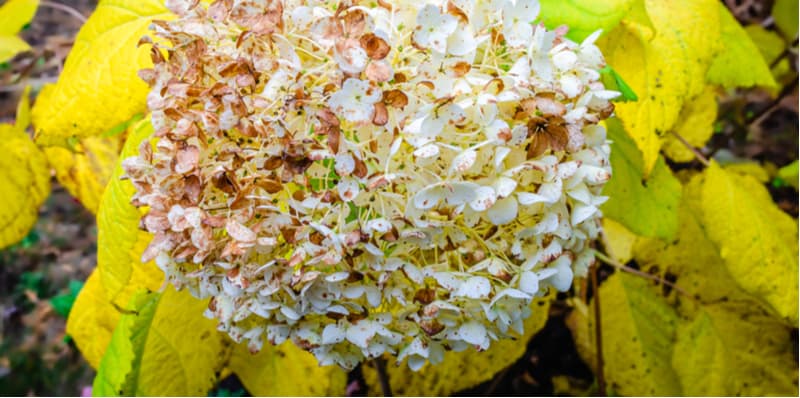The Main Principles Of Hydrangea Leaves Turning Yellow
Table of ContentsThe smart Trick of Hydrangea Leaves Turning Yellow That Nobody is Talking AboutThe 4-Minute Rule for Hydrangea Leaves Turning YellowWhat Does Hydrangea Leaves Turning Yellow Do?What Does Hydrangea Leaves Turning Yellow Do?All about Hydrangea Leaves Turning YellowHow Hydrangea Leaves Turning Yellow can Save You Time, Stress, and Money.
One opportunity is that the plant is not obtaining sufficient sunlight. During the winter months, the days are shorter, and the sunlight is not as extreme, so make certain to position your Hydrangea in an area where it will certainly access least 6 hours of sunlight each day. Another factor for Hydrangea yellow fallen leaves in wintertime might be excessive water.The leaves might be transforming yellow due to temperature stress. Hydrangeas like cooler temperature levels, so if the plant remains in an area that obtains as well hot or also chilly, the leaves will certainly turn yellow. If you assume temperature level tension may be the problem, try relocating your Hydrangea to a different area or securing it from the elements with a cloth wrap.
New development will be observed in very early springtime, when you'll see eco-friendly foliage growing from stems that might have shown up dead. Nonetheless, if your leaves are transforming brownish in springtime or summertime, there are most likely various other factors at play. The exact reasons depend upon the variety and their expanding problems, but in basic, brown hydrangea leaves suggest dehydration and wilting in the warm
Some Known Facts About Hydrangea Leaves Turning Yellow.

Wilting is triggered by lack of wetness, meaning there are a few great methods to use to avoid this from occurring. Offer your hydrangeas a healthy glug of water every few days when the temperatures are climbing high, and treat the soil to far better preserve moisture. After watering, a dab of mulch around the base of each plant ought to assist with this by maintaining dampness in the dirt.
This interrupts fungi spores from resolving. "The Botrytis fungus flourishes in amazing and damp problems, so prevent bathing the entire plant when sprinkling and simply water at the origins," shares Roy Nicol, a Master Green thumb. If you've missed the chance for prevention and are taking care of an infection you must get rid of all dead or severely infected fallen leaves from the plant and damage them to stop further spread.
Some Known Details About Hydrangea Leaves Turning Yellow
As a general general rule, we advise eliminating leaves when they are 50% brownish or higher. While browning triggered by any kind find this of factor can't be turned around, taking the restorative action defined above will urge the plant to expand brand-new fallen leaves so the harmed leaves either diminish normally or can be gotten rid of by the garden enthusiast.
Hydrangeas must be watered just when the top couple of inches of soil are completely dry, and ought to be offered a detailed soaking each time. Underwatered hydrangeas are most likely to have yellow, wilting, and sagging leaves. Raise the frequency and quantity of watering for your bush to help fix this issue. Hydrangeas favor fairly damp (but not soggy) dirt, so give the origins an excellent soaking and permit water to be absorbed into the dirt before applying extra.
The method you deal with hydrangea leaves transforming yellow depends on the essential concern causing the yellow leaves. This can be hard to identify, once you do you will be able to adjust your link plant care appropriately to look after the problem. As discussed previously, an usual concern with hydrangeas is nutrient deficiencies.
Hydrangea Leaves Turning Yellow - The Facts
Throughout the height expanding season, you ought to water at a rate of Going Here concerning 1 inch weekly. If you are stressed over not effectively watering your hydrangeas, there are a pair of points you can do. Adding mulch to the base of the plants over the origin area assistance to regulate the temperature around the shrub and maintain water in the soil.
Additionally, you can acquire and mount simple watering worlds. Sprinkling globes hold water in them and slowly release this water right into the dirt as the ground ends up being dry. Merely load the globe with water, stick the spout into the dirt within the root area near the base of the plant, and leave it in area up until all the water is gone.
If it is also extreme, some plants will certainly never ever recuperate from transplant shock and will continue to decrease up until they die. Minimize transplant shock by including as several origins as feasible when digging up your plant to relocate. Make sure to supply more water than usual in the weeks following planting to help your plant recoup and expand new roots.
How Hydrangea Leaves Turning Yellow can Save You Time, Stress, and Money.
To prevent spreading out fungal diseases, make sure to thouroughly clean and sanitize any pruning devices before and after usage. Finally, you can try to flush the origins with water to remove excess fertlizer.
Your hydrangea plant favors well-drained, moist soil. If the pot has bad water drainage, or your dirt is flooded, the leaves will certainly start to turn yellow.
If you don't sprinkle your hydrangea plant for even more than a week, the fallen leaves will start turning yellow. Fungal conditions that strike the plants often tend to show indicators on the roots and the leaves of the plant.
See This Report on Hydrangea Leaves Turning Yellow
